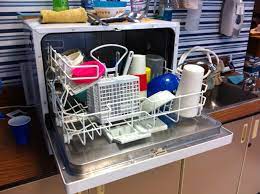Is A Portable Dishwasher Worth It?
Portable dishwashers are smaller versions of built-in dishwashers. The only thing that makes them different is their portability, capacity, and usage.
Yes, portable dishwashers are worth it. These gadgets use less water compared to the other methods of dishwashing.
They are also economical in terms of cost, water, and electricity usage. The best part, they can fit a variety of spaces.
You’re not restricted to placing it in specific sections of the kitchen like a built-in type of dishwasher.
You only need to figure out the flow of water, especially when draining to run the machine smoothly.
You can also comfortably move from one house to another without engaging a professional to remove it. Unplug and move.
Another advantage of a portable dishwasher is that you can convert it into a built-in if you need to.
This works when you are able to get adequate space under the sink or cabinet.
Portable and countertop dishwashers have similar and even better functionality than some built-in types.
They offer several wash cycles such as cleaning, sanitizing, and drying.
You can get up to ten options with delay wash options depending on the brand.
Read: How Long Does A Dishwasher Take to Run?
How Does a Portable Dishwasher Drain?
At the back of the portable dishwasher, there are three main lines.
Two hoses are joined to one another by a unicouple, and a separate cable which is the power supply.
Between the two hoses, one is for supplying hot water to the dishwasher while the other one drains.
The unicouple that links the hoses enables you to hook it to the tap faucet. It also has a draining facility that allows water from the dishwasher to come out.
You’ll need an adaptor for the faucet to connect the unicouple.
Most portable dishwashers come with a faucet adaptor and washers. If one is not available, you can buy one from a local hardware or plumbing store.

Do Portable Dishwashers Dry Dishes?
Yes, portable dishwashers dry dishes. How well the portable machine dries the dishes depends on the drying system it uses.
The drying cycle either uses condensation or heat drying.
When heat drying, the heating element first raises the temperature of the air in the dishwasher.
The air fans then force the hot air in the machine out through the vents.
The moisture in the dishwasher and dishes is transformed into steam. The dishes dry up as the steam leaves through the exhaust vents.
For condensation drying, the last cleaning cycle involves rinsing the dishes with hot water which creates a temperature difference.
The stainless steel interior becomes cooler than the dishes, leading to the water condensing on them.

The cooler sections continue to pull the water off the dishes and it drains from the dishwasher.
Heat drying is considered more efficient compared to condensation cooling. However, it requires more time and consumes more power.
The majority of manufacturers are moving towards condensation cooling to minimize energy use and offer sustainability.
A great option is to go for air-drying. Make use of the temperature around the room and give time for the dishes to dry on their own.
It might require you to slightly open the dishwasher door once the cycle is complete.
This will facilitate the movement of warm air from the dishwasher speeding up the drying process.
Opening the door also minimizes the build-up of mold and other bacteria that may cause the dishwasher to smell.
It may also help to use dishwasher rinse and dry aid to make sure the dishes are spot-free and dry completely.
Do Portable Dishwashers Use a Lot of Water?
No, portable dishwashers don’t use a lot of water. A portable dishwasher uses 1.3 to 3 gallons (5 to 11 liters) of water per cycle.
The amount of water a machine uses depends on the capacity and specific cycle.
The water that a portable or countertop dishwasher uses is 5 times less than handwashing the same quantity of utensils.
Having carried out a test on different dishwasher brands and sizes, we were able to determine the exact amount they use.
The following table shows our results;
| BRAND | CAPACITY (PLACE SETTING) | WATER USAGE (LITERS) | WATER USAGE (GALLONS) |
| Danby | 6 | 11.7 | 3.1 |
| Moosoo | 6 | 5 | 1.3 |
| Farberware | 6 | 6.5 | 1.7 |
| Bosch | 6 | 8 | 2.1 |
| KAPAS | 6 | 5.4 | 1.4 |
| Teka | 6 | 6.5 | 1.7 |
| Airmsen | 4 | 5 | 1.3 |
| Novete | 4 | 5 | 1.3 |
| Aikoper | 3 | 6 | 1.6 |
| SPT | 8 | 20 | 5 |
| Black and Decker | 6 | 7 | 1.8 |
| Hissun | 4 | 5 | 1.3 |
| CalmDo | 3 | 5 | 1.3 |
| SPT | 6 | 10.8 | 2.8 |
| Haimim | 6 | 9 | 2.4 |
It is clear that the larger the capacity of the dishwasher, the more water it consumes per cycle.
It’s recommended to use Energy Star-rated and certified dishwashers.
These products aid in saving water and electricity usage as they are manufactured with technology that enhances effectiveness.
They improve on the design, the water system, filters, and sensors.
Can You Hook Up a Portable Dishwasher Permanently?
Yes, you can hook up a portable or countertop dishwasher permanently. However, not all brands can be converted into a built-in dishwasher.
You need to check on the design to ensure you can connect the inlet and drain pipes to your kitchen plumbing system.
There are portable dishwasher brands that come with built-in water tanks. And it would be a challenge to use it as a built-in.
Brands that offer the option of converting a portable to a built-in often state this in their product description.
It is advisable to check for these instructions or contact the support team for advice. Alternatively, consult a plumber before opting to convert your dishwasher.
Remember portable and countertop dishwashers are designed for users looking for convenience when it comes to movement and space.
Conclusion
Portable dishwashers are a worthwhile investment.
They work as well as built-in dishwashers. Not to mention, they consume less water and power saving your overall costs.
Portable and countertop dishwasher beat handwashing anytime.
If you are limited by space, you can easily store the dishwasher and use it when you have a full load.
There are many brands to choose from. Check on the design, size, price, functionality, noise level, and rating.

